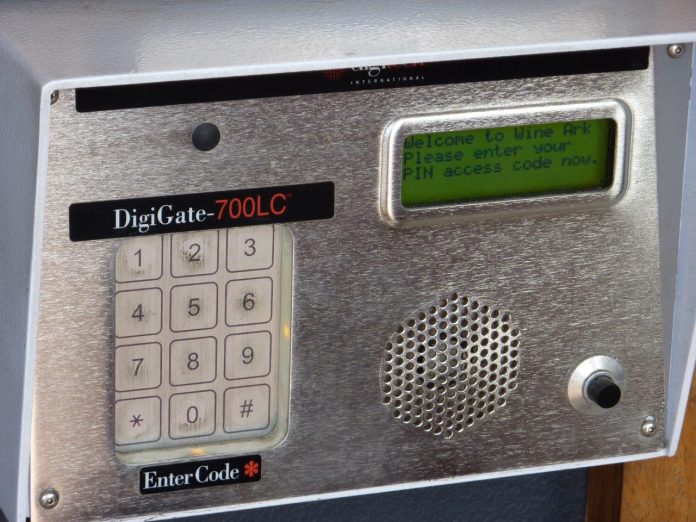Wine Ark in Alexandria in Sydney has installed a DigiTech access control and alarm system and management software, reporting through a Concept 3000 panel. An analogue CCTV solution handles local and remote video surveillance.
HOUSING and protecting hundreds of millions of dollars worth of fine wine, Wine Ark in Alexandria is located inside a towering concrete industrial unit with a very large and very heavy timber door clamped with a big FSH electromagnetic lock. You climb up onto a high-waisted concrete slab to reach this door so there’s no way anyone can break into the site using a motor vehicle.
These physical barriers are only the outermost layer of security at Wine Ark, with multiple layers of access control ensuring only authorised customers and staff can get into the facility. This is not accidental. Unlike so many applications which tack on the bare minimum of protection, Wine Ark’s security is front and centre – a vital element of the overall service.
Wine Ark’s service lets wine buffs, dealers or retailers store between 100 and 100,000 bottles in an individually secured and a climate controlled environment. Key aspects of the Wine Ark service that are promoted to clients include biometric fingerprint scanners, a PIN-coded security tag access system, a CCTV surveillance system, back-to-base alarm monitoring, remote alarm reporting, alarm detection including movement (PIR and reed), temperature, vibration and 24 x 7 onsite security guards and patrols.
On meeting Wine Ark’s CEO John Cuff, his passion for wine and for the wine business is immediately apparent. Cuff, whose background is wine retail, takes sales calls from over Australia, and he points out that it’s vital staff love wine, know wine and understand its storage needs, given they are talking to wine people.
“This is a unique business – it’s not a place you keep your drinking wine, Cuff tells me. “Wine Ark is where you store special bottles of wine for long periods – it might be that 6-12 bottles of special wine you want to look after, or it might be a dozen cases or more. It’s 3 dollars a case per month to store wine so it’s very affordable.
“Given the high value of the wine we store, security is important to our clients and to us,” he explains. “We have alarms, access control, CCTV, back to base monitoring. There are hundreds of sensors across the site – PIRs, reeds, vibration sensors. Another key aspect is temperature control to 12-13 degrees, which is monitored as well.”
“Our video footage and alarm events are accessible on our mobile devices and we have remote control of access control functionality where we need it”
Something else that’s integral is customer engagement in the storage process. Each case of wine put into managed cellarage is inspected, catalogued and labelled with a unique identification barcode. A customer’s inventory is then uploaded into the online cellar management system.
As each case is added or removed from the wine collection, records are automatically updated so customers always know the state of their cellar. This is important from the point of view of the future when cloud-based surveillance and security systems allow more customer involvement.
According to Cuff, wine storage is a long term relationship.
“You have a rapport with clients and you can work with them so they appreciate and understand operational processes – lead times to access wine at busy times of the year and security procedures. They understand and expect these things. Premium wine is a luxury, let alone have many dozens of bottles and storing it, so wine people are passionate.
“Storing their wine, drinking their wine, thinking about the last bottle of a particular wine they have. It’s aspirational. If someone has hundreds of thousands of dollars worth of wine they have collected over many years, they need to be able to speak to people who speak the same language, who know the value of a single bottle from a particular vineyard in a particular year, who will protect their wine. That’s the business we are in.”
Wine Ark has been around for 15 years. The business started at Camperdown, expanded to Chatswood and then to this site at Alexandria 12 years ago. The security solution we are looking at was installed and integrated 12 years ago and at that time represented the best balance of performance and economy.
“At that time the site was a high-span warehouse,” Cuff explains. “Our landlord put in a massive concrete slab for us but this aside, the facility we have today was purpose-built for our requirements. It’s a big concrete bunker really, which is ideal for security and controlling temperature.”
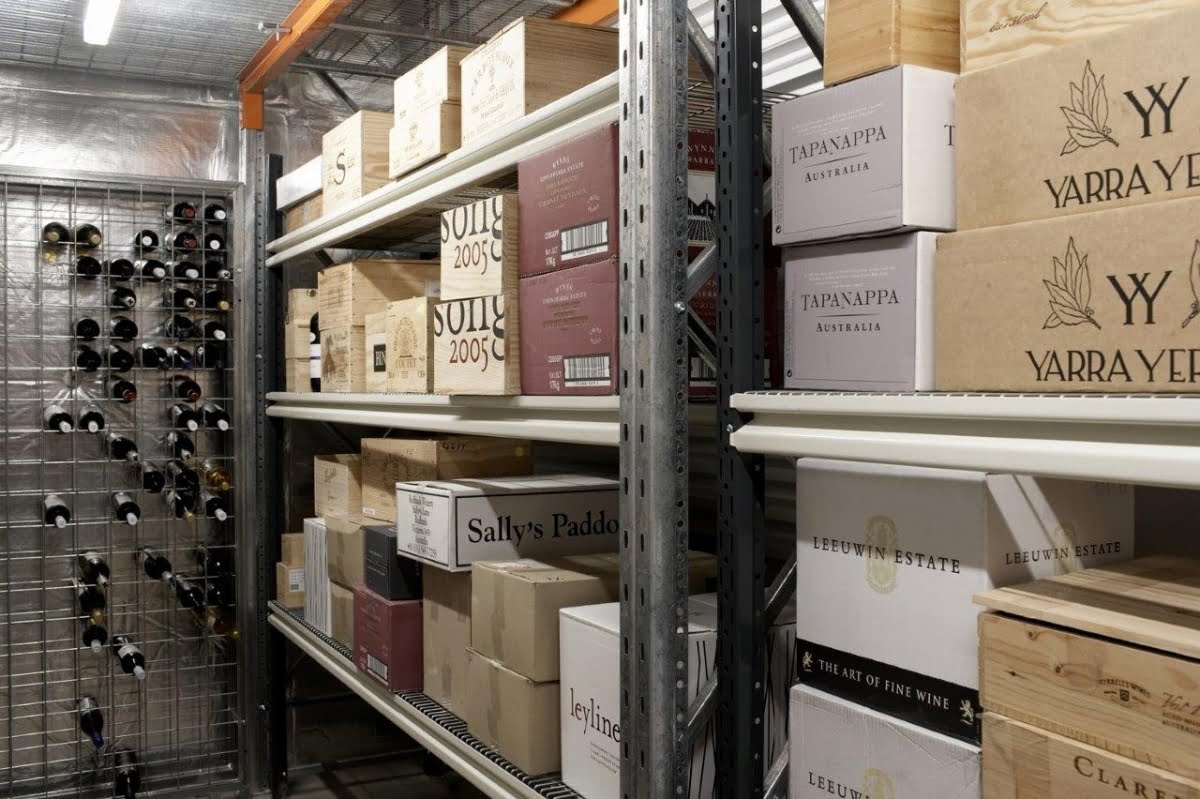
The DigiTech solution
Involved from the outset was integrator Martin Dugdale of Holdfast Security and before we go inside the facility, he points out that massive steel framed timber door.
“The first thing you notice is that this door is more suited to a castle keep. It’s designed to give an impression – you’re not getting in here unless you belong,” Dugdale explains. “It’s an excellent expression of CPTED principles, as is that concrete slab which protects against ram raids.”
Every site has a defining aspect, a characteristic that governs the nature of the entire application. Wine Ark’s is this. The site has 2500 alarm inputs, including hundreds of reed switches on individual vaults, as well as PIRs, vibration sensors and temperature sensors. This meant the system selected had to be affordably expandable on a grand scale. Further, because Wine Ark has 3500 customers, the security system needed to be able to support thousands of PIN codes – and few systems do.
Dugdale found the solution in DigiTech, an American solution that supports access control and intrusion alarms and is renowned for its highly expandable and robust bus-based architecture, as well as keypads of great physical integrity.
According to Dugdale, he’d seen all kinds of keypads but when he saw how robust the DigiTech 7000 keypad was, he knew it was ideal for an application like this one, whose first line of defence was entry of a customer PIN into a keypad in an external environment. The overall DigiTech solution at Wine Ark comprises Digitech DigiGate Controllers, Digitech Multiplexers, DigiTech 7000 keypads and DigiTech 700 management software, which allows operators to see the condition of the entire site at a glance.
“What governs this system is the underlying fundamental that self storage facilities like this one can have thousands of customers, each with an individual access code,” Dugdale tells me.
“That access code has to get customers through the main door, into the lobby and once they get through the biometric entry, that same code also has to disarm one or more of their storage areas inside the vault. So we need one code to do 2 or 3 jobs, which is unusual.”
This part of the system is driven by the DigiTech DigiGuard and given it’s a product most people would be unfamiliar with, it’s worth delving a little deeper. The DigiTech system at Wine Ark is governed by DigiGate system controllers and DigiGate software, which handle intrusion detection and access control. The software allows monitoring and control and both PC and syscon store customer and event data so as to provide redundancy.
The system controller and DigiGate-700 software simultaneously monitor, process, and store system activity. They accommodate up to 64 keypad/time zones and 4000 alarm points. The software allows management to change access zones, and run multiple reports with only a few mouse clicks. DigiGate-700 software allows use of multiple codes per unit or assignation of multiple units per code.
“The way this solution is different to most access control systems is that with DigiTech you can have 2000 different codes, each one linked to a different arming situation”
Meanwhile, the DigiGate-700 system controller controls devices for access and exit, timed activities, and alarm monitoring. The controller interfaces with a Wine Ark PC for report generation and tracking of customer activities. Importantly, each controller is equipped with built-in surge suppression and automatic power backup.
DigiTech’s DigiGate 7000 heavy gauge aluminium keypads incorporate functions like LCD screens, a built-in intercom and card readers. The keypads can accept over 50 million actions and withstand the most extreme weather. Easy to install and configure, the keypads have easy-to-use connections and are easily added into the standard DigiGate-700 software. There’s an on-board tamper switch, device operating relay, 2 independent alarm inputs to the system, and as a measure of the manufacturer’s faith, a lifetime warranty.
“The way this solution is different to most access control systems is that with DigiTech you can have 2000 different codes, each one linked to a different arming situation,” Dugdale explains.
“And the nature of the system means all the alarm inputs can’t report back-to-base. When this system went in, the only comms we had was contact ID which offers just 256 alarm codes, so on a site like this it’s useless. To get anything off site we had to use a relay from the DigiTech controller to a Concept 3000 panel.”
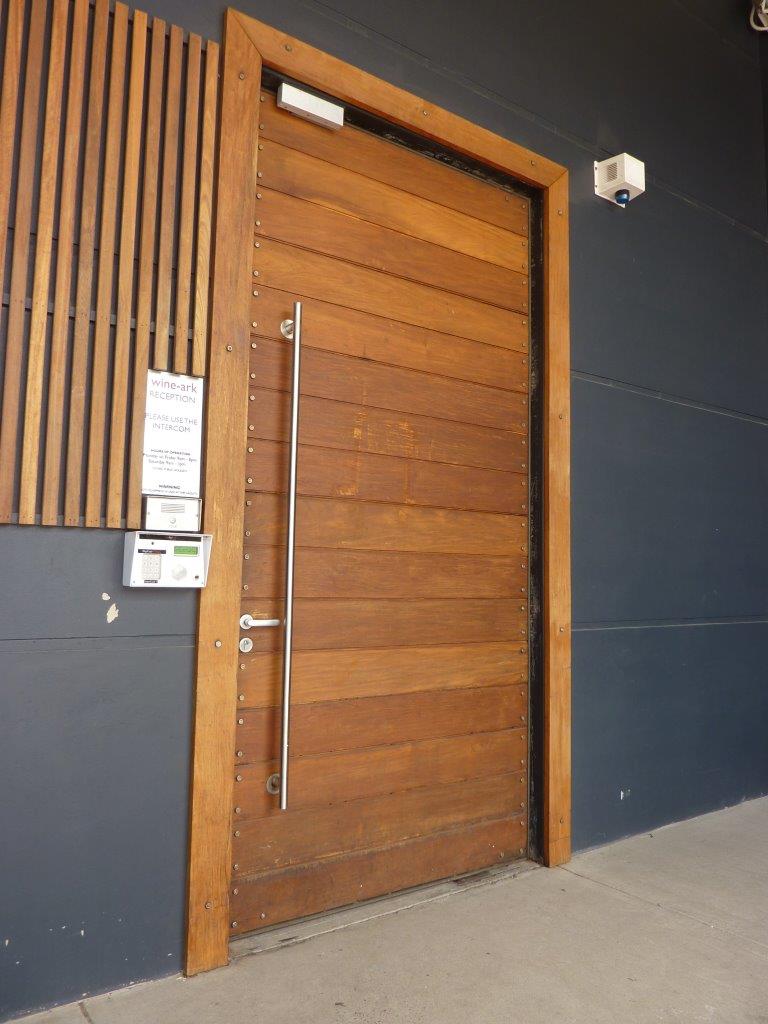
Designed in layers
As Dugdale explains, the electronic security system is designed in layers. A PIN code gets customers through the front door into the lobby. A biometric authentication procedure gets customers from the lobby into the vault and once in the vault, their PIN code allows them to access their individual storage areas. There’s a simplicity and cleverness to this solution. It means the tough DigiTech 7000 keypad can act as doorman, while sensitive biometric readers make absolutely certain of identity before allowing access to the vault.
“We took our time planning the installation and getting this site set up properly,” Dugdale explains as he offers his PIN code to the hulking DigiTech keypad. “We have layers of security all monitored back to base. Starting at the front door we have keypad entry to get into the lobby.”
He pushes open the front door and we walk into the lobby, a quiet, high-roofed space flanked by wine racks. Swinging around I see there are cameras here and what look like wide angle Paradox PIR sensors – perfect for a stable, cool thermal environment like this one. In fact it’s hard to think of a more blissful environment for a PIR.
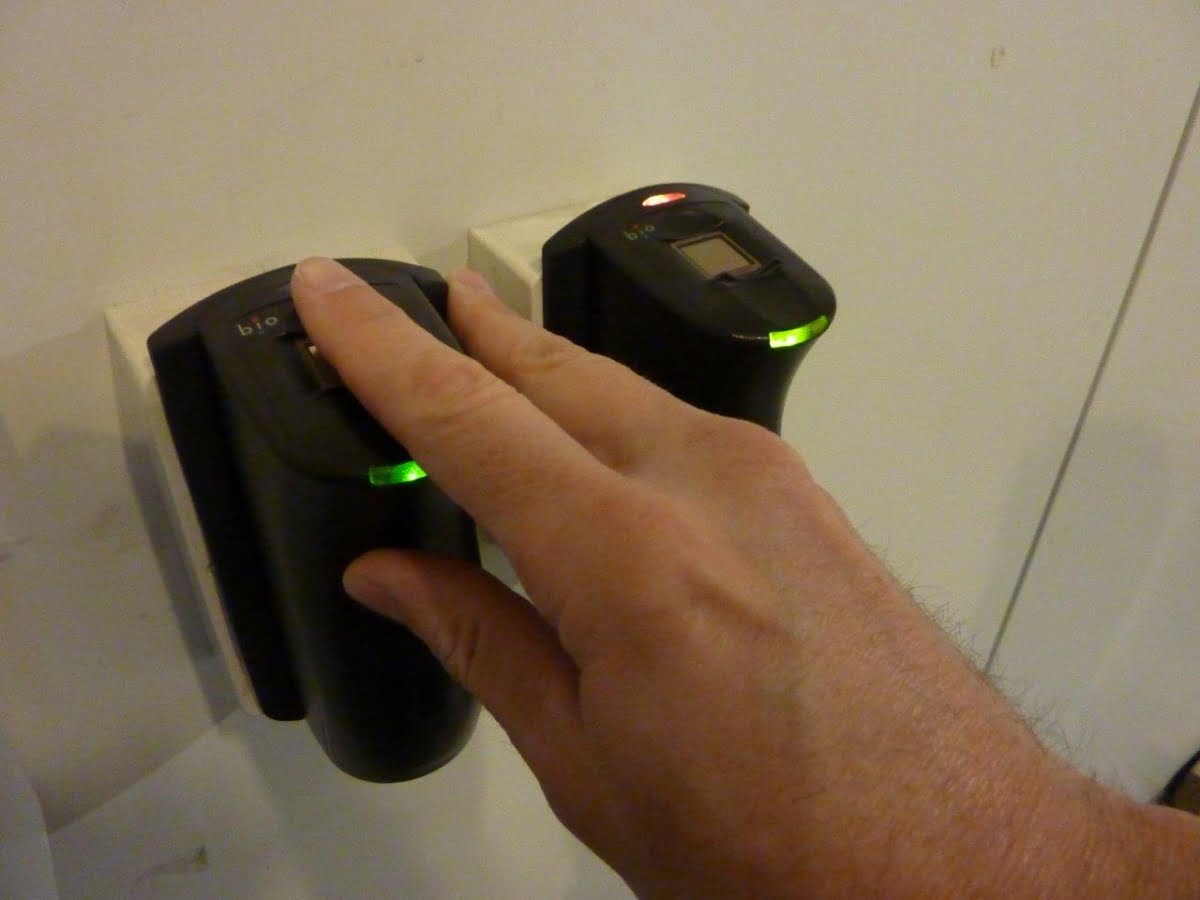
Kantech’s BioScrypt V-Smart-A-H biometric readers
At the far end of the lobby there’s an insulated door that leads to the self storage wine vault secured with another magnetic lock and activated using a pair of Kantech’s BioScrypt V-Smart-A-H biometric readers. Cuff authorises our entry into the vault with his fingerprint on the neat-looking Bioscrypt readers and we go through the door into the cool, thrumming heart of the Wine Ark.
The metal skeleton, ladders and scaffoldings, the surface-mount pipes and conduits and the white noise of air conditioning units bring to mind the lower decks of one of Her Majesty’s Australian ships. We are on the vault level, which is self storage. Above is the managed storage used by the trade for handling and filtering valuable wine stocks for stores or restaurants.
Walking down the dim main corridor, storage cul de sacs lined with timber-doored lockers stretch out into lateral darkness. My first impressions are the size of the operation. It’s big. The sub-systems governing the facility are comprehensive at all levels, power, air conditioning, fire control, security, lighting.
The other pronounced sense is that it’s dark. There’s a reason for this. Ultraviolet light can cause hydrogen sulphide compounds to develop in wine, so Wine Ark needs to keep lighting at a bare minimum. Clearly, this is a challenge from the point of view of surveillance. Minimum scene illuminations in many parts of Wine Ark are sub 10-lux and in corners, sub 5-lux. IR seems an ideal solution to me, but not being a wine buff I’m uncertain how the infrared spectrum would impact on bouquet.
“These storage cupboards are unlike other storage facilities and they are designed for atmosphere,” Cuff explains as we check out the smaller storage spaces. “They’re all timber, and each has a wired reed switch alarm sensor.
“And these are our walk-in 220 case vaults,” Cuff says, unlocking a secure door and walking into a significant storage space around 3m high, with comprehensive and deep shelving.
It’s all so big – maintaining temperature and security coverage – you must have back up power? I ask.
“That redundancy is all provided by South Sydney Business Park – it comes from the common grid,” Cuff says. “And yes, we have full redundancy on climate control, too. There are 3 chillers upstairs so it’s more than fully redundant. We’ve used 1 air conditioning unit at 65 per cent during the winter, so there’s capacity to spare.”
Along another wing of storage units, Dugdale takes the cover off a metal housing.
“This is an unexpanded Digitech multiplexer that can handle up to 110 alarm inputs,” he tells me. “It has 3 boards at the moment and each board can handle 22 alarm inputs. There are 2 of these multiplexers per area here in self storage. The multiplexers are linked by RS-485 to a controller in a central location.”
Meanwhile, the surveillance side of the system is analogue and performance is adequate, given the fact analogue CCD’s typically handle low light very well compared with the IP surveillance cameras of 2001. No surprisingly in a facility like this one, there are pools of light and areas of darkness.
“Current camera performance is fine – we don’t have cameras covering every aisle, it’s the access points and the thoroughfares that matter,” says Cuff. “The system gives an idea of events, rather than face recognition inside the facility. Of course, by the time you get into the facility, the system already knows for certain who you are, thanks to the biometric readers.”
Cuff points out that something very important for Wine Ark management when it came to electronic security, including CCTV, was the ability to manage functionality remotely.
“The surveillance system is more client-related from the point of view of functionality – it allows management to verify identity remotely when managing access, which is very useful on a site with low staff numbers,” he explains.
“If a client calls me and says they can’t get into their vault for any reason I can verify their identity, check their account to make sure payments are up to date and then automatically open locker doors from home. A key aspect of the system for me is that I can do everything remotely.”
On the surveillance side there are plans for an upgrade and given the customer-centric nature of the service, part of an IP-based surveillance system might include a cloud-based service that allows users to see their precious vintage.
“We are currently testing and considering a number of options,” Cuff says. “The new solution will be IP and will be accessible remotely via Internet connected computers or mobile devices.”
Next we climb a flight of stairs into the managed storage area. It’s a big space this, with towering racks of wine challenging surveillance and intrusion detection coverage. Cameras are focused on walkways and in this area I can see there are PIRs installed at the end of each row on both sides of a central corridor.
Walking towards the PIRs in the storage aisles – which is not a strength of their detection characteristics – I notice they pick me up almost immediately. The only thing I can put this down to, other than a pulse count advance, is the cool environment making me a more noticeably warm-blooded target.
The installation
How did Holdfast Security get involved in the installation?
“Dean Reilly was the guy who was first involved with this installation and I got a call just before they started building Wine Ark and came down for a look,” Dugdale tells me. “From there it just grew and grew and grew. I think all up the installation process took 8-9 months, given we were working during the build.”
Wine Ark is a big site. There are dividing walls, multiple levels, conduits carrying power and multiple systems to be integrated. This system is entirely hardwired – it has to be given the shielding created by the metal structures that make up the facility’s internal structure. And given the zone loops are fairly long it’s hard not to imagine there would be some challenges on a site like this.
But surprisingly, Dugdale, who was involved from the word go, says the physical installation was the easiest part of the job. The challenges came with power and integration of the biometric readers into the DigiTech control units.
“In terms of the physical installation, that was easy – there’s no pre-cabling through the slab – there’s no need – exposed conduits are ok in this sort of environment and they are easier for installers,” explains Dugdale.
“Power and software are the biggest challenges you ever find from an integrator’s point of view, in my opinion. Once we got power supply issues sorted and everything talking, it worked very well. The first year was tricky, getting everything working but it’s been very stable since then.”
When you say ‘tricky’ what does that mean exactly?
“DigiTech systems are engineered for durability and reliability so there were never going to be fundamental problems there,” says Dugdale. “From my point of view, the biggest challenge was getting the Bioscrypt biometric readers connected to the DigiTech system controllers powered correctly, then getting the readers up in software and then getting that software linked to the DigiTech system controllers.
“That integration process was undocumented,” Dugdale points out with a wry chuckle. “After making a request for information we eventually we got a very cryptic email from DigiTech saying something like: ‘there’s no guarantee you won’t lose all data during this process but this is how you upgrade’. So John and I sat down and followed the process step by step and it worked.”
The control room
Our final port of call is the control room where the DigiTech control panels and the Concept 3000 slave are installed.
“This is a rather more congested panel that normal because we’ve also got the biometric readers coming into it, which made things more difficult during installation,” Dugdale tells me, opening a housing.
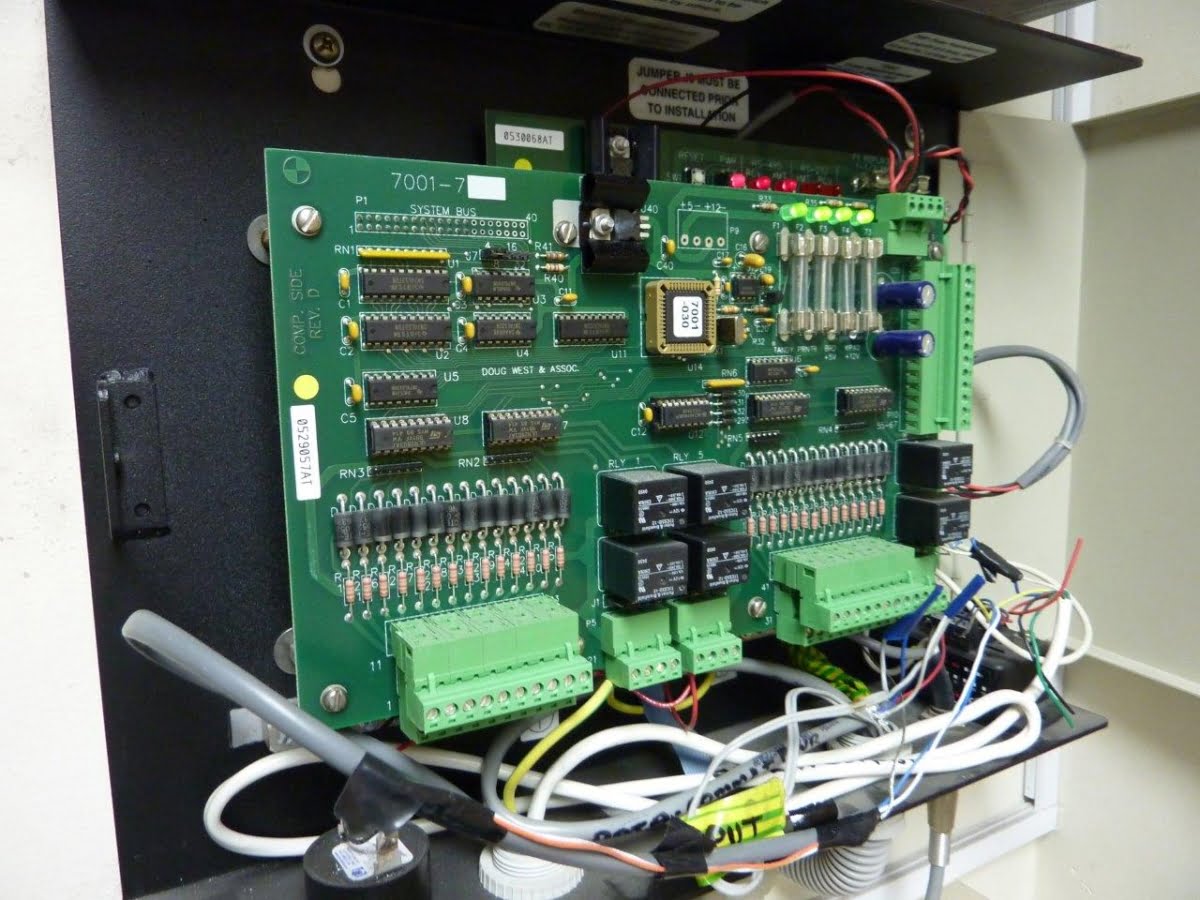
Digitech 7000 controller
“It’s a very simple controller but it has a great deal of redundancy built into it. For instance, this DigiTech syscon polls the RS-485 LAN constantly. It knows when a multiplexer goes off line and will continue to attempt to connect. When the multiplexer comes back online it will the tell management software a connection has been re-established.
“For added security there’s a kill switch in the controller. If an intruder meddles with a controller and inadvertently hits the switch, the controller will dump all client data so there’s no way to gain access without going back to software to reload customer data codes and biometrics – it’s like a tamper. But if the computer goes offline, the remote control unit will continue to manage the system through its distributed intelligence.”
As mentioned, the only connection between the DigiTech controller and the Concept 3000 doing alarm reporting is a single relay giving a single alarm event to the monitoring station. Site management then goes through the onsite logs to ascertain exactly what the alarm event was post-event.
“As I pointed out earlier, there is no comms protocol capable of turning 2500 line events into software so that means you get a general alarm if a sensor or switch in the vault is tampered with – you don’t know which one at the monitoring end,” Dugdale explains.
“It’s a challenging brief. Fortunately the nature of the overall system – which means we always know exactly who has access to the vault – means any alarm events can be sheeted home to the handful of people on site at a given time.
“We certainly looked at having the alarm events related to a local multiplexer but decided it didn’t give us any more information. So basically what you need to do when there is an alarm event is look at the cameras and see what’s happening or log into the system and view events which are logged in detail.
“There’s no point trying to get anything other than a single alarm condition into monitoring station with this application. As soon as the system delivers more than one alarm event you have to start making choices and the choices became impossible.”
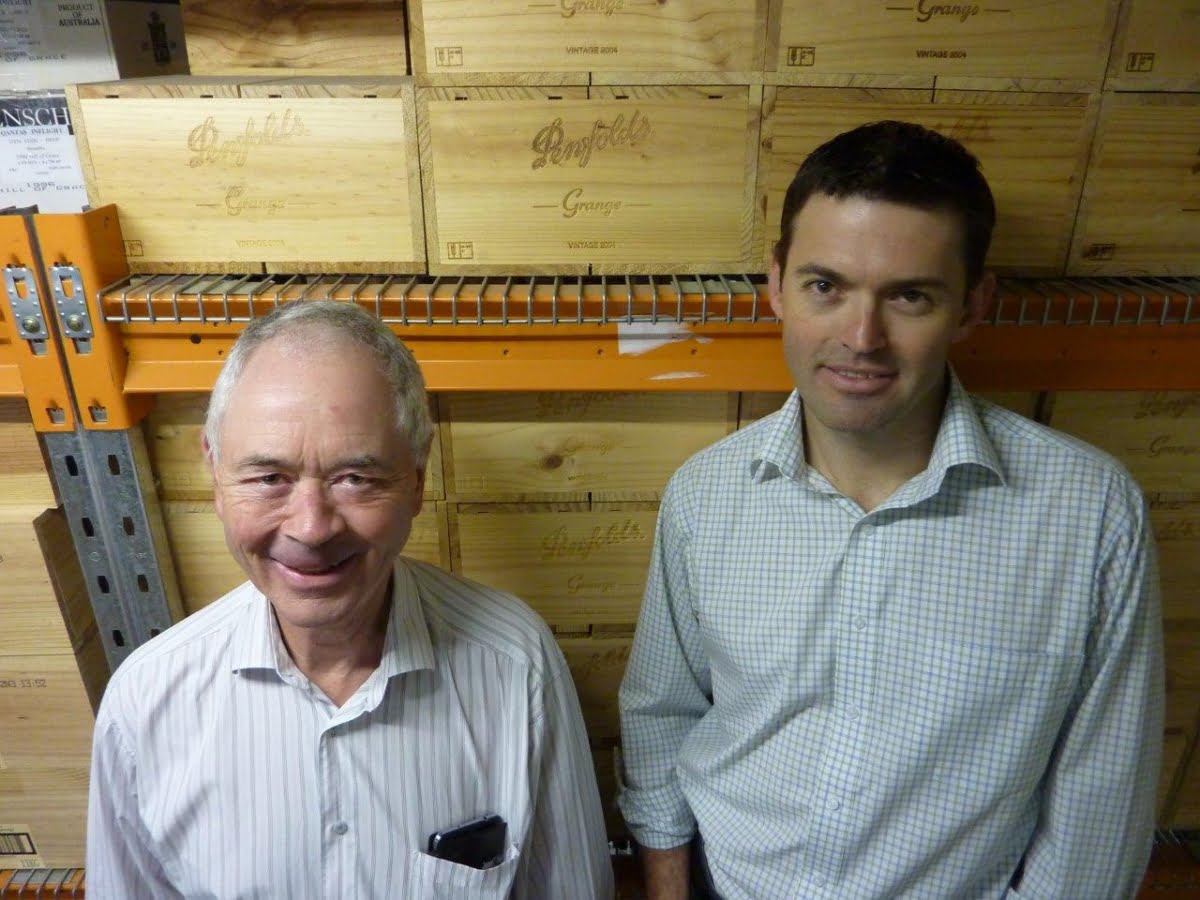
Martin Dugdale (left) and John Cuff
Conclusion
Wine Ark’s security solution is a fascinating one. Faced with a number of problems unique to this application, Holdfast came up with an integration that offers layered security in a flexible and affordable way. Even after more than a decade I don’t know a solution that would support the challenges the DigiTech is handling here – thousands of codes driving multiple devices.
“Wine storage is a very niche application and it’s one of the only industries where security is not a reluctant purchase,” Dugdale says with a note of genuine appreciation in his voice. “People in this business want security – they want to show it off to their customers as a marketing tool. Those sorts of applications are few and far between and are a pleasure to work on.”
What about from an operational point of view – any challenges for the end user?
“We haven’t had any dramas with the system,” says Cuff. “Bogan moth season can be interesting with false alarms, but overall the system is self sufficient and well supported. Our video footage and alarm events are accessible on our mobile devices and we have remote control of access control functionality where we need it.”
“If a client calls me and says they can’t get into their vault for any reason I can verify their identity, check their account to make sure payments are up to date and then automatically open locker doors from home”
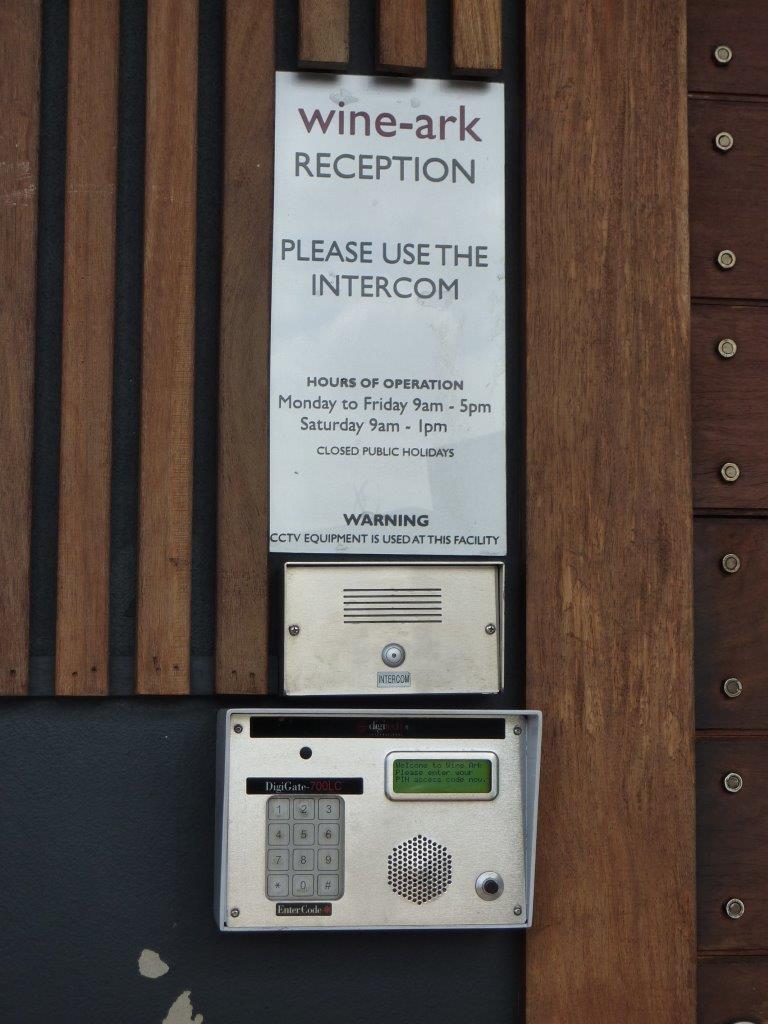
By John Adams



